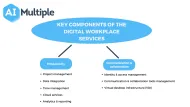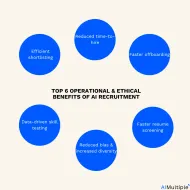AI Resume Screening: 8 Benefits For Hirings Managers in 2024
There are currently more than 5M1 million job openings in the US. This presents an unyielding challenge for hiring managers who would face a mountain of applications, obstructing them from giving each candidate a thorough evaluation.
The implications of an inadequate resume screening is two-fold:
- Hiring the wrong candidates
- Missing out on suitable recruits
To avoid this, companies should automate their candidate screening process with artificial intelligence tools. This article will explore what AI resume screening is, its 8 benefits, and the top AI tools you can use to automate the screening process.
What is AI resume screening?
AI resume screening is using different types of artificial intelligence tools to automate the resume screening process and data extraction, such as the candidate’s work experience, age, education, skills, etc. to ensure they meet the job description.
By automating the initial screening phase with AI resume screening tools, companies can process large volumes of applications efficiently. This allows the HR staff to dedicate their time interacting with the best candidates who are most aligned with the job description.
Learn more about how AI can be used in the recruitment process.
What are AI screening tools?
Resume screening is part of the hiring process that also comprises sourcing, interviewing, and hiring candidates.
So because the resume screening process is interconnected to other factors, we found no software provider offering resume screening tools as a standalone solution. All vendors that we found, like Workday or Oracle’s Recruiting Booster, offer resume screening as part of a comprehensive talent acquisition package, that also automates job posting, scheduling interviews, onboarding, and more.
How do resume screening tools work?
A resume screening tool leverages natural language processing (NLP) and natural language understanding (NLU) to understand and interpret the text in resumes, through tokenization, entity recognition, and semantic analysis. Then each employee is given a score against the criteria set by the employer (thanks to an RPA bot that follows a rule-based framework), and ranked accordingly.
What are the benefits of automating the screening process?
1. Unbiasedness
Automated resume screening eliminates unconscious bias in the hiring process, ensuring a fair and objective evaluation of all candidates.
For instance, once data is extracted from resumes and put into the company’s internal database, RPA bots can be programmed to mask the applicants’ name, gender, and nationality, referring to them as, “Candidate 1, 2, 3, etc.”
This would eliminate biases and level the playing field.
2. Fast
A reason why filling a position takes time is because of the high number of received applications.2
Artificial intelligence tools would scan resumes faster than humans would. 2 This not only advances qualified candidates quicker, but enables the HR staff to give each a more personalized overview.
For example, Isagenix3, a health and wellness company, achieved a 50% faster time-to-fill by integrating background screening, faster application processing, and automating the overall recruiting process.
Learn more about HR automation use cases.
3. Engaging
Thanks to recruitment chatbots embedded into talent acquisition solutions, resume screening can also be transformed into an engaging experience. The chatbot, for instance, can be programmed to ask questions on topics that aren’t usually put on resumes, but would provide insight into the applicant’s personality, ambitions, and suitability.
75%4 of candidates never hear back from a hiring manager after applying for a job. The chatbot could also notify applicants on their application status. So, if they are eliminated, they’d at least receive a courtesy message.
Learn more about conversational AI and digital workers.
4. Improved matching
Thanks to matching algorithms and numerical models, candidates would more accurately be matched with job criteria.
For instance, a position’s screening criteria might demand German fluency. So, once a resume has been scanned, bots would search for the phrase, “fluent in German” or something equivalent, like “German fluency: 4/5.” Or, in case of exceptions, like a resume claiming “fluency in many languages,” a ticket can be issued to look more into it.
These tools improve the shortlisting accuracy. A Chinese finance company, as an example, improved its hiring accuracy by 90%5 via a chatbot that pre-screened candidates by asking relevant questions and advancing them to the next round if answers matched the custom criteria.
5. Standardized
Because resume screening software has business engine rules, a standardized criteria can be applied across all departments.
For instance, a company might need all applicants to have at least 2 recommendations from their former employers. So automatically, all applicants’, regardless of the position they’re applying for, who don’t meet the requirement would be eliminated.
PwC6, by digitizing the various aspects of its recruitment process, has standardized its hiring across all its global divisions, from China and US that recruit hundreds of thousands of employees, to small territories that employ 15 people a year.
6. Improved analytics
The screening tools we encountered are all cloud-based, with analytics and integration features, with the applicant tracking system, for example. This gives hiring managers all the relevant analytics data they need for their talent management, such as:
- The total number of applications
- Industry benchmarks
- Origin of applications
- Time-to-fill
- Time-to-screen
- Diversity funnel
7. Scalable
AI based resume screening allows companies to hire for multiple open positions simultaneously, without sacrificing the screening standard.
For example, Dentsu7, an advertisement firm, was able to fill 4-5 positions after a successful recruitment month. After automating their screening and assessment processes, they now hire up to 25 people monthly.
8. Exception-handling
The recruitment software can create tickets for exceptions and refer them to the hiring managers for further assessment if their suitability for a particular job opening is above a certain threshold but below a definite assessment.
This decreases the number of qualified candidates who don’t get a chance to redeem themselves if a small section of their resume is incomplete.
For more on recruitment automation
To learn more about recruitment automation, read:
And if you still have question on how to automate your recruitment process, reach out to us:
External Links
- 1. “Jobs in United Sates.” LinkedIn. Retrieved on August 22, 2023.
- 2. “How Long Do Hiring Managers Look at a Resume?” Indeed. July 8, 2022. Retrieved on August 22, 2023.
- 3. “Isagenix International.” icims. Retrieved on August 22, 2023.
- 4. “Statistics: Rethink Your Candidate Experience or Ruin Your Brand.” Human Capital Institute. October 1, 2018. Retrieved on August 22, 2023.
- 5. “A Multilateral Financial Institution boosts its hiring accuracy by 90% to find the best candidates with impress.ai.” Impress.ai. Retrieved on 19 December, 2022.
- 6. “Hiring for growth in a complex.” Workday. Retrieved on August 22, 2023.
- 7. “How Dentsu Is Using Vervoe To Create Realistic Job Previews.” Vervoe. Retrieved on August 22, 2023.

Cem has been the principal analyst at AIMultiple since 2017. AIMultiple informs hundreds of thousands of businesses (as per similarWeb) including 60% of Fortune 500 every month.
Cem's work has been cited by leading global publications including Business Insider, Forbes, Washington Post, global firms like Deloitte, HPE, NGOs like World Economic Forum and supranational organizations like European Commission. You can see more reputable companies and media that referenced AIMultiple.
Throughout his career, Cem served as a tech consultant, tech buyer and tech entrepreneur. He advised businesses on their enterprise software, automation, cloud, AI / ML and other technology related decisions at McKinsey & Company and Altman Solon for more than a decade. He also published a McKinsey report on digitalization.
He led technology strategy and procurement of a telco while reporting to the CEO. He has also led commercial growth of deep tech company Hypatos that reached a 7 digit annual recurring revenue and a 9 digit valuation from 0 within 2 years. Cem's work in Hypatos was covered by leading technology publications like TechCrunch and Business Insider.
Cem regularly speaks at international technology conferences. He graduated from Bogazici University as a computer engineer and holds an MBA from Columbia Business School.
To stay up-to-date on B2B tech & accelerate your enterprise:
Follow on

Comments
Your email address will not be published. All fields are required.